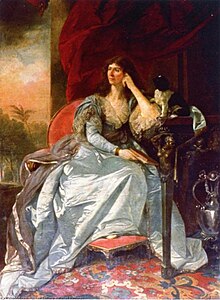Marian Hastings
Marian Hastings | |
|---|---|
 by Johann Zoffany | |
| Born | 2 February 1747 Nuremberg |
| Died | 1837 Daylesford House |
Marian Hastings (1747–1837) born Anna Maria Apollonia Chapuset who became Marian von Imhoff, Baroness von Imhoff. She met Warren Hastings on a ship bound for India. While she and Warren remained on good terms she divorced her husband who painted miniatures and married Hastings. Hastings went on to govern Bengal. They retired to England together and her son inherited their house and estate.
Life[edit]
Hastings is believed to have been born in Nuremberg in 1747. One source says on the 2 February. Her parents were Johann Jakob and Caroline Friederike (born Grundgeiger or Krongeiger) and she had a younger brother named Johann Paul Thomas. Her father died in 1758.[1]
She married Carl von Imhoff who was a painter and became the German Baroness Marian von Imhoff in the 1760s.[1] In 1768 she came to England with her husband and two sons after Elizabeth Schwellenberg who was a mistress of the robes to Queen Charlotte arranged for their emigration. Her husband found work with the East India Company as a cadet in their Madras Company. He could be a soldier but his major skill was painting miniatures.[1]
She and her husband were on board the Duke of Grafton at Dover in March 1769 en route for India. When a fellow passenger Warren Hastings became ill, Marian began to care for him. Hastings was travelling to Madras where he was to be the city's deputy ruler. He was a widower as Hastings' first wife, Mary, had died ten years before.[1]

They fell in love and they began an affair, seemingly with her husband's consent. The divorce took a long time and it was not until 1777 when news came from Germany that Hastings was finally able to marry her in August 1777 in Calcutta.[1] She had returned to her maiden name before the wedding where she described herself as a single woman.[1] Theirs was a happy wedding, Warren was his own man, but he took her views into consideration. She seems to have kept some secrets as Warren estimated her fortune at one point as £40,000 but others estimate it to be over £100,000.[1]
In the 1780s they were living near Culcutta where they had a country home at Alipore. George Thompson, who was Warren Hastings secretary in Calcutta, advised his boss in 1784 that he and his wife should sit for a painting. Thompson said that if it was a good likeness then an engraving should be made as there many poor likenesses of Hastings in circulation. The German painter Johann Zoffany created a painting of them but it was not delivered in 1784[2] when she left India because of her health. Warren joined her in Britain in 1785.[1]
In 1788 she appeared in two satirical prints by the satirical cartoonist James Gillray.[3]
Her husband died in 1818 at Daylesford. A memorial was erected to him in Westminster Abbey by M.A.Hastings.[4]
Death and legacy[edit]
She died in 1837 at Daylesford House and her son inherited the house.[1]
In 2018 her personal seal that was made from a Columbian emerald in a Mughal style in 1783 or 1784 was auctioned by Bonhams. It sold for about £180,000.[5]
References[edit]
- ^ a b c d e f g h i Matthew, H. C. G.; Harrison, B., eds. (2004-09-23), "Marian Hastings", The Oxford Dictionary of National Biography, Oxford: Oxford University Press, doi:10.1093/ref:odnb/63512, retrieved 2023-06-12
- ^ "Warren Hastings - Person Extended - National Portrait Gallery". www.npg.org.uk. Retrieved 2023-06-12.
- ^ "Collections Online | British Museum". www.britishmuseum.org. Retrieved 2023-06-12.
- ^ pixeltocode.uk, PixelToCode. "Warren Hastings". Westminster Abbey. Retrieved 2023-06-12.
- ^ "Bonhams: An Important Mughal emerald seal made for and bearing the name of Marian Hastings, wife of Warren Hastings, Governor General of India 1773–1785 North India, dated AH 1198/ AD 1783–4". bonhams.com. Retrieved 2023-06-12.
